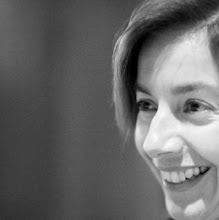What helps me most when sitting every morning? Remembering some basic teachings from the Frames of Reference.
Here they are, translated in plain English:
Here they are, translated in plain English:
[He] remains focused on the body in and of itself — ardent, alert, and mindful —
First starting with mindfulness of the body. First noticing the sensations in the feet, then moving up to the thighs resting on the chair, then becoming aware of the whole body sitting still.
putting aside greed and distress with reference to the world.
Setting aside ordinary preoccupations. Telling myself, now is not the time to plan or worry. Now is the time to practice mindfulness.
[He] sits holding his body erect and setting mindfulness to the forefront. Always mindful, he breathes in; mindful he breathes out.
Sitting up straight, turning the attention to the breath.
He trains himself, 'I will breathe in sensitive to the entire body.' He trains himself, 'I will breathe out sensitive to the entire body.'
With each breath in and out, sensing the whole body.
He trains himself, 'I will breathe in calming bodily fabrication.' He trains himself, 'I will breathe out calming bodily fabrication.'
In the process, noticing any tightness in the body, and relaxing the tension
When feeling a painful feeling, [he] discerns, 'I am feeling a painful feeling.' When feeling a pleasant feeling, he discerns, 'I am feeling a pleasant feeling.' When feeling a neither-painful-nor-pleasant feeling, he discerns, 'I am feeling a neither-painful-nor-pleasant feeling.'
Noticing the quality of the experience, whether pleasant, unpleasant, or neither.
[He] remains focused on the phenomenon of origination with regard to feelings, on the phenomenon of passing away with regard to feelings, or on the phenomenon of origination and passing away with regard to feelings.
Getting to see the constantly changing nature of the quality of the experience - pleasant one moment, then becoming unpleasant, etc . . .
"When the mind has passion, he discerns that the mind has passion. When the mind is without passion, he discerns that the mind is without passion. When the mind has aversion, he discerns that the mind has aversion. When the mind is without aversion, he discerns that the mind is without aversion.
Noticing either clinging or aversion. Do I like this, or do I dislike this?
"When the mind is constricted, he discerns that the mind is constricted. When the mind is scattered, he discerns that the mind is scattered [...] When the mind is concentrated, he discerns that the mind is concentrated. [...] When the mind is released, he discerns that the mind is released [...]
Noticing the quality of the mind itself. Tightness around thoughts? Scattered? Concentrated? Calm? whichever the quality, noticing.
[He] remains focused on the phenomenon of origination with regard to the mind, on the phenomenon of passing away with regard to the mind, or on the phenomenon of origination and passing away with regard to the mind.
Focusing on the nature of thought making process, not the thought themselves. Thoughts coming and going . . .
[He] remains focused on the five hindrances. [When] sensual desire is present within, [he] discerns that 'There is sensual desire present within me.' Or, there being no sensual desire present within, he discerns that 'There is no sensual desire present within me.' He discerns how there is the arising of unarisen sensual desire. And he discerns how there is the abandoning of sensual desire once it has arisen. And he discerns how there is no future arising of sensual desire that has been abandoned. (The same formula is repeated for the remaining hindrances: ill will, drowsiness, anxiety, and doubt.)
Recognizing each of the five hindrances: craving of pleasure, anger or hate, dullness, restlessness and anxiety, doubt about practice. Catching each one at whichever stage it may be in: just nascent or full blown. Hindrances can be strong but focusing on the nature of the hindrance itself, not its object, can help one let go of it.
There is the case where he discerns, as it has come to be, that 'This is stress.' He discerns, as it has come to be, that 'This is the origination of stress.' He discerns, as it has come to be, that 'This is the cessation of stress.' He discerns, as it has come to be, that 'This is the way leading to the cessation of stress.'
Seeing for oneself the connection between clinging and stress in both body and mind.
This is where I am at with my practice. This is what I understand.
How about you? Which wisdom do you bring in each time you sit?




No comments:
Post a Comment